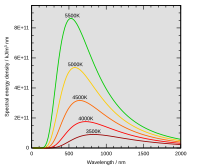
Photo from wikipedia
Abstract One of the nanofluid application is concerned with cooling hot surfaces with different shapes. In this study, the cooling impacts of nanofluid on a hot surface was numerically compared… Click to show full abstract
Abstract One of the nanofluid application is concerned with cooling hot surfaces with different shapes. In this study, the cooling impacts of nanofluid on a hot surface was numerically compared with base fluid, and the accuracy of the results was validated with available experimental data. There are a minimal number of numerical studies of free surface jet flows mainly with nanofluids. The complexity of the simulation comes from the fact that both the multiphase approach of the jet flow and particle tracking of the nanoparticles are needed to be taken into account. VOF model from a multiphase approach was employed to simulate the interaction between air and fluid and eventually provide a realistic air-liquid interface. Discrete phase model was used to track nanoparticles in the flow field. It was also crucial to understand the effects of roughness on the cooling of the hot surface and temperature distribution. The results show that roughness could increase heat transfer up to some specific amount. However, further growth in roughness may cause adverse effects on the flow and heat transfer. An optimum value for roughness corresponding to maximum heat transfer was found. Based on the obtained data, a correlation was developed for optimum roughness. Nanoparticles were tracked by DPM to get different particles velocity and turbulent parameters in each computational cell. In spite of velocity reduction, heat transfer was enhanced by roughness due to improved effective thermal conductivity.
Journal Title: International Communications in Heat and Mass Transfer
Year Published: 2020
Link to full text (if available)
Share on Social Media: Sign Up to like & get
recommendations!